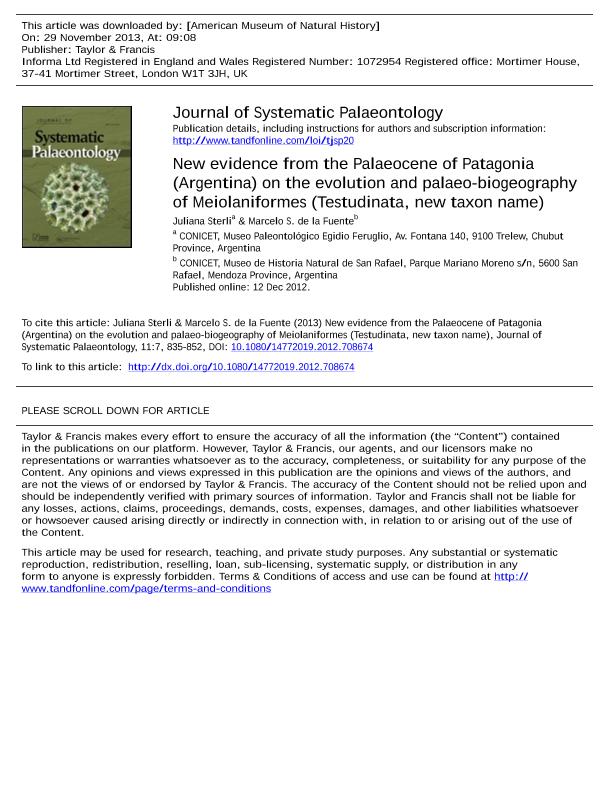Mostrar el registro sencillo del ítem
dc.contributor.author
Sterli, Juliana

dc.contributor.author
de la Fuente, Marcelo Saul

dc.date.available
2015-12-28T19:03:52Z
dc.date.issued
2013-12-12
dc.identifier.citation
Sterli, Juliana; de la Fuente, Marcelo Saul; New evidence from the palaeocene of patagonia (Argentina) on the evolution and palaeo-biogeography of meiolaniformes (Testudinata, new taxon name); Taylor & Francis; Journal of Systematic Palaeontology; 11; 7; 12-12-2013; 835-852
dc.identifier.issn
1477-2019
dc.identifier.uri
http://hdl.handle.net/11336/3254
dc.description.abstract
Peligrochelys walshae gen. et sp. nov. is a new stem turtle closely related to the clade Meiolaniidae found in the Palaeocene levels of the Salamanca Formation (Maastrichtian-Danian) of central Patagonia, Chubut Province, Argentina. A phylogenetic analysis shows that Peligrochelys walshae forms a monophyletic group with Mongolochelys efremovi, a clade that, in return, is the sister group of a clade formed by Patagoniaemys gasparinae, Otwayemys cunicularius, Kallokibotion bajazidi and Meiolaniidae. Meiolaniidae is recovered deeply nested in a monophyletic group (Meiolaniformes, newtaxon name) dominated by Gondwanan taxa (e.g. Chubutemys copelloi, Patagoniaemys gasparinae, Otwayemys cunicularius and Peligrochelys walshae), that also includes some notable Laurasian representatives (Mongolochelys efremovi and Kallokibotion bajazidi). The biogeographic scenario presented here supports the hypothesis that this group of turtles may have originated as early as the Early Cretaceous in the South American part of Gondwana. The long ghost lineage that extends below this clade suggests that it may have originated any time between the Early Jurassic and the Early Cretaceous, implying a Pangaean or Gondwanan origin for the clade, respectively. The phylogenetic scenario presented here shows that at least two lineages (Peligrochelys walshae and Meiolaniidae) of Meiolaniformes survived the K-P boundary extinction. Another interesting characteristic of meiolaniform turtles in the fossil record is their frequent association with another clade of strictly Gondwanan distribution, the pleurodiran clade Chelidae. This association is typically found in outcrops from the Early Cretaceous to the Eocene in central Patagonia, and in the Early Cretaceous and from the Miocene to the Pleistocene in Australia.
dc.format
application/pdf
dc.language.iso
eng
dc.publisher
Taylor & Francis

dc.rights
info:eu-repo/semantics/openAccess
dc.rights.uri
https://creativecommons.org/licenses/by-nc-sa/2.5/ar/
dc.subject
Peligrochelys Walshae
dc.subject
Phylogeny
dc.subject
K-P Extinction
dc.subject
Chelidae And Meiolaniidae Association
dc.subject.classification
Paleontología

dc.subject.classification
Ciencias de la Tierra y relacionadas con el Medio Ambiente

dc.subject.classification
CIENCIAS NATURALES Y EXACTAS

dc.title
New evidence from the palaeocene of patagonia (Argentina) on the evolution and palaeo-biogeography of meiolaniformes (Testudinata, new taxon name)
dc.type
info:eu-repo/semantics/article
dc.type
info:ar-repo/semantics/artículo
dc.type
info:eu-repo/semantics/publishedVersion
dc.date.updated
2016-03-30 10:35:44.97925-03
dc.journal.volume
11
dc.journal.number
7
dc.journal.pagination
835-852
dc.journal.pais
Reino Unido

dc.journal.ciudad
Londres
dc.description.fil
Fil: Sterli, Juliana. Museo Paleontologico Egidio Feruglio; Argentina. Consejo Nacional de Investigaciones Científicas y Técnicas. Centro Nacional Patagónico; Argentina
dc.description.fil
Fil: de la Fuente, Marcelo Saul. Consejo Nacional de Investigaciones Científicas y Técnicas. Centro Científico Tecnológica Mendoza. Instituto Argentino de Nivología, Glaciología y Ciencias Ambientales. Museo de Historia Natural de San Rafael; Argentina
dc.journal.title
Journal of Systematic Palaeontology

dc.relation.alternativeid
info:eu-repo/semantics/altIdentifier/url/https://www.tandfonline.com/doi/full/10.1080/14772019.2012.708674
dc.relation.alternativeid
info:eu-repo/semantics/altIdentifier/doi/http://dx.doi.org/10.1080/14772019.2012.708674
Archivos asociados
